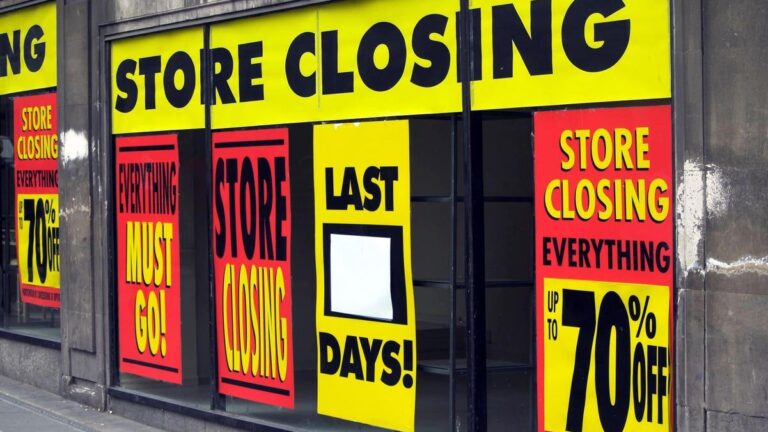
The Impact and Consequences of Store Closing: A Comprehensive Analysis
In the dynamic landscape of modern retail, store closing have become an increasingly common event. Whether it’s a small boutique or a large, established chain, businesses across the globe are facing the painful yet necessary decision to close their physical stores. These Store Closing may be a result of a variety of factors—ranging from shifting consumer behaviors, economic pressures, technological advancements, and the ongoing impact of global events like the COVID-19 pandemic. This article explores the multifaceted reasons behind Store Closing, the impact on local communities, employees, and the broader economy, and what the future holds for the retail industry.
The Rise of Store Closures
In recent years, store closing have dominated headlines across the world. A notable trend has been the bankruptcy of well-known retail chains, such as Sears, J.C. Penney, and Toys “R” Us in the United States. According to a report by Coresight Research, the U.S. saw over 9,000 store closures in 2020 alone, a stark increase from previous years. The rise of e-commerce, changes in consumer preferences, and external economic factors have all contributed to the decision to close physical retail locations.
E-Commerce and the Shift in Consumer Behavior
The rise of e-commerce and online shopping has been one of the primary drivers of store closing in recent years. Retailers like Amazon, which operate exclusively online, have changed the way consumers shop. The convenience of shopping from home, the ability to compare prices easily, and the fast delivery options have all made it harder for brick-and-mortar stores to compete.
Furthermore, online shopping offers a wider range of products and better accessibility, with no need for customers to visit a physical store. The shift toward e-commerce has caused many consumers to rethink how they engage with physical retail stores. For some businesses, maintaining expensive real estate to offer products that are readily available online simply doesn’t make financial sense. The cost of operating a physical store, including rent, utilities, and staff, becomes unsustainable when compared to the lower overhead of e-commerce models.
Changing Consumer Preferences
As consumers increasingly prioritize convenience, the demand for physical stores is diminishing. Younger generations, particularly Millennials and Gen Z, have embraced the online shopping experience to such an extent that they now make up a significant portion of consumer spending. Their affinity for online platforms, mobile apps, and social media marketing has led to a shift in how retail businesses approach their sales strategies.
Moreover, the concept of “experience over product” has become a dominant trend in consumer culture. Customers today are more likely to seek out experiences, such as dining, entertainment, and travel, rather than purchasing physical goods. Retailers who have not adapted to this changing mindset, especially those that rely on outdated business models, are finding it increasingly difficult to attract foot traffic to their stores.
The Economic Impact of Store Closures
When a major retail chain announces the Store Closing, the impact is felt not only by the company and its employees but also by the surrounding community and economy. Physical retail locations are often integral parts of local economies, generating tax revenue and creating jobs. For every large store that shuts down, there are consequences for local businesses, real estate markets, and consumers.
Job Losses and Employee Welfare
One of the most immediate and visible consequences of Store Closing is the loss of jobs. Retail jobs, which often provide entry-level employment opportunities for many individuals, are heavily impacted. The Store Closing can lead to layoffs for workers, including sales associates, cashiers, managers, and support staff. Many of these jobs may not easily be replaced, particularly in communities where retail is a significant employer.
The challenge for employees facing store closures is multifaceted. They may find it difficult to secure new employment in an increasingly competitive job market, and those who are able to find new work may have to accept lower wages or fewer benefits. Some workers may also struggle with the emotional toll of losing a job that they’ve held for years, particularly in cases where the company has been an integral part of their identity and livelihood.
Impact on Local Businesses
Local small businesses are often collateral damage in the wake of large retail Store Closing. In many cases, large retailers serve as anchor stores for shopping centers, attracting foot traffic that supports smaller shops in the same vicinity. When these big-box stores close, smaller local businesses may struggle to stay afloat without the customer base that was once guaranteed by the nearby larger retailer. This can lead to a ripple effect, where one store closure causes a chain reaction, ultimately leading to the decline of an entire shopping area.
For instance, when malls lose big brands, they lose their ability to attract shoppers, leading to lower sales for smaller tenants. Retailers who rely on impulse buys or frequent visits from mall-goers are particularly vulnerable. As mall vacancies rise, the real estate market in the area can also face significant declines, with vacant storefronts often sitting unused for extended periods.
Decline in Local Tax Revenue
Another significant impact of store closing is the decline in local tax revenue. Retail stores contribute to local economies not only through job creation but also through property taxes, sales taxes, and other related revenue streams. The loss of major retail stores means a decrease in taxable sales and a potential reduction in overall property values. This can be particularly problematic for cities and municipalities that depend on retail taxes to fund essential public services, including schools, roads, and public safety.
Real Estate Consequences
The real estate market is deeply affected by Store Closing. Commercial real estate developers face challenges in filling vacant spaces, particularly in areas with declining foot traffic. The abundance of vacant retail spaces can drive down property values, making it harder for landlords to find new tenants willing to pay premium rents. This phenomenon has led to the repurposing of empty retail spaces into alternative uses, such as office spaces, apartments, or even fulfillment centers for e-commerce giants.
In some cases, large retail closures can contribute to urban blight, where whole shopping centers or districts become desolate and unattractive. These areas can then become hotspots for crime or other societal problems, which further exacerbates the decline of the local economy.
The COVID-19 Pandemic and Accelerated Store Closures
The global COVID-19 pandemic served as a massive accelerator for the trends that were already affecting the retail industry. Lockdowns, social distancing, and health concerns led to the temporary or permanent closure of many retail stores worldwide. During the height of the pandemic, shoppers turned almost exclusively to online platforms, further reinforcing the preference for digital over physical shopping.
Many businesses, particularly in non-essential sectors, faced temporary store closures as they complied with government-mandated restrictions. However, for some businesses, these closures became permanent as the financial impact of extended shutdowns took a significant toll. Retailers like Neiman Marcus, J.C. Penney, and others filed for bankruptcy in 2020, citing the pandemic as a primary factor in their financial distress.
In response to the pandemic, many retailers began to embrace new strategies, such as contactless payment systems, curbside pickup, and more robust e-commerce operations. However, for those businesses that couldn’t pivot quickly enough, the closure of physical stores became a necessary step in staying afloat during an otherwise challenging time.
The Future of Retail: What Comes Next?
While store closing represent a painful reality for many businesses, they also present opportunities for innovation and reinvention in the retail industry. As more consumers embrace the convenience of e-commerce, brick-and-mortar stores are evolving to adapt to new shopping behaviors. Some are transforming into experiential destinations, offering customers unique, personalized experiences that can’t be replicated online. These stores focus on providing an immersive environment, leveraging augmented reality, interactive displays, and hands-on demonstrations.
Retailers are also investing in omnichannel strategies, ensuring a seamless experience across both online and physical touchpoints. In this future model, physical stores become hubs for services, product demonstrations, and last-mile delivery, with e-commerce platforms handling the bulk of transactions. Brands that effectively combine the advantages of both online and offline shopping are likely to thrive in the new retail ecosystem.
Conclusion
Store closures are a complex phenomenon that affects many facets of society, from the economy and local communities to the future of retail. While these closures are often a direct result of shifting consumer behaviors and technological advancements, they also reflect broader structural changes in the economy and retail landscape. The rise of e-commerce, changing shopping habits, and unforeseen global events like the COVID-19 pandemic have accelerated this trend.
The impact of store closing is deeply felt by employees, local businesses, and communities at large. However, with the right strategies, the retail industry can reinvent itself to remain relevant in an increasingly digital world. The future of retail lies in understanding and adapting to consumer preferences, blending online and offline experiences, and providing value in ways that go beyond the product itself. As the industry continues to evolve, businesses must innovate and rethink their approach to physical retail, embracing change as an opportunity for growth in an ever-changing environment.



